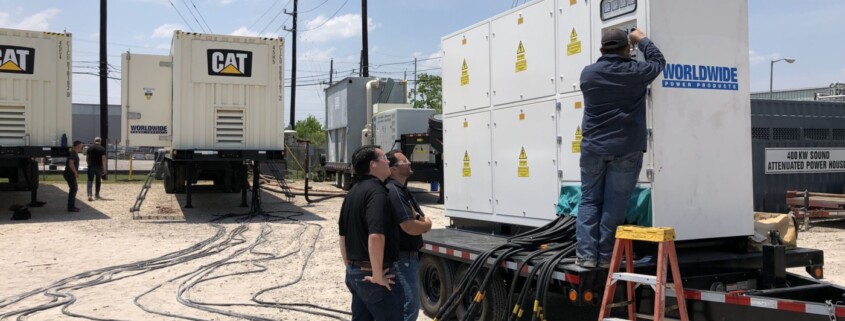Load Bank Types: Resistive vs Reactive vs Resistive/Reactive vs Electronic
Generators are often kept for the purpose of emergencies. By their very nature, emergencies often transpire unexpectedly, and that’s why operations and facilities, particularly those in the oil and gas industry or services industry (e.g., data centers and hospitals), have generators onsite for standby purposes. A permanent or portable backup generator can give you peace of mind knowing you have a reliable source of power to fall back on. What happens, however, if the backup genset suddenly doesn’t work?
It can be costly on many different fronts, from production costs to the cost of human lives, when a standby generator fails to perform during times of emergencies. That’s why most operations and facilities have plans for emergencies and disasters – load bank testing should be a component of those plans.
Generator load bank testing is meant to ensure your backup source of power remains reliable and provides maximum performance when needed.
Generator load bank testing refers to a process to assess a generator’s capabilities, verifying all genset components are in optimal working condition under different loads. As it is, standby and emergency generators are not always run on a regular basis, so it is important to run tests to make sure they can run your operations or facility at their full kilowatt ratings.
- The standard rule (according to NFPA testing guidelines) is: conduct a load bank test on any generator not run at more than 30% of its rated kW load (or as recommended by the manufacturer).
- The aim of load bank testing is: make sure your generator maintains the proper pressure levels and temperature while it also produces optimal horsepower needed for your operations or facility.
The load bank testing procedure (see how it works in detail) works by placing an artificial or dummy load on the generator. The testing is timed according to industry standards and regulatory codes. The load is gradually increased. The engine and alternator are recorded at all times. An assessment of the data is then done. The only equipment required to perform the test is the load bank.

When Do You Need Generator Load Bank Testing?
Load bank testing allows you to verify the generator system’s capabilities, which cannot be verified via routine start-ups. The testing also allows you to identify problems early before the problems either lead to expensive repairs or failure to perform when needed. But testing is not a mere recommendation, regulations also require it under some circumstances. For instance, NFPA 110 requires emergency generators to be tested monthly if (1) the generator is meant to protect occupants of a commercial building; and (2) the failure of the same could lead to bodily injuries or death. Testing requirements also vary according to if the generator is fueled by diesel or run on electric. For most standby systems, especially those in place to prevent economic losses or interruptions to business, annual testing may be enough.
Again, testing is dependent on the industry, regulations, generator energy source, and the generator’s purpose. As another general rule, testing should also be undertaken when the generator is new or when it has been commissioned in order to establish a baseline for future operational performance.
The 4 Types of Load Banks
There are four types of load banks that can be used for testing generators, and these are:
- Resistive
- Reactive
- Combined resistive/reactive
- Electronic.
Depending on your purpose, you may opt for a permanent load bank or a rental load bank that is mobile for the convenience of transport and use. Each load bank type — as delineated above — has its benefits and its disadvantages.
1. Resistive
Resistive load banks are the most common. The resistive load bank allows you to test a prime mover and a generator at 100% capacity. This method employs a straightforward process for measuring loads: electrical energy is converted to heat via resistors, and the heat dissipates via air or water.
This type simulates real-life loads, including prime mover capacity (kW), prime mover controls, and transient response (Hz), but has limited testing capabilities of alternator capacity (kVAR), alternator controls, load-sharing controls (kW only), distribution bus, and transient response (voltage).
Resistive load banks come in a wide array of options, from their portability to their size to their power range:
- DC portable
- AC small portable
- AC large portable
- AC trailer mounted
- AC stationary
- AC medium/high voltage
- AC radiator cooled
- AC water-cooled.
These options allow you to test according to your specific design criteria and operational needs. Resistive load banks may best be used for:
- Generators with a capacity less than 200 kVA
- Portable generators
- Small generators
- UPS systems.
2. Reactive
A reactive load bank tests loads with either a capacitor or an inductor in the load. The process is one that converts electrical energy into a magnetic field. Inductive loads are more common than capacitive load banks. The inductive load bank can test only up to 75% of full power testing while capacitive load bank testing performs about the same except it creates leading power factor loads, which mimic some electronic and non-linear loads.
Reactive load banks are suitable for testing motor-driven devices and transformers, usually those in the telecommunications and UPS industries.
3. Combined Resistive/Reactive
Combined resistive/reactive load banks utilize characteristics found in resistive load banks as well as characteristics the latter is unable to measure. Resistive/reactive load banks can test:
- Prime mover capacity (kW)
- Prime mover controls
- Alternator capacity (kVAR)
- Alternator controls
- Load-sharing controls (kW and kVAR)
- Distribution bus
- Transient response (Hz)
- Transient response (voltage).
Resistive/reactive load banks may best be used for:
- Generators with a capacity greater than 200kVA
- Generators with a capacity from 1 MVA onwards
- Single units
- Multiple units.
4. Electronic
The electronic load bank can test for average and peak load capacities. To perform the test, an electrical load is applied to the power source. The electronic load bank is superior and results in more precise data than the results derived from other load bank types and testing. The disadvantage is in the price — electronic load bank testing is more expensive. Electronic load banks are programmable and can be employed to test all sizes of generator systems in any given industry.
Power On with Worldwide Power Products
At WPP, we offer load banks to buy and rent from our base in Houston, TX. We also provide load bank testing services, either as a stand-alone service or as part of our preventive maintenance program.
It is our intent to keep the power on, even in times of emergencies.











